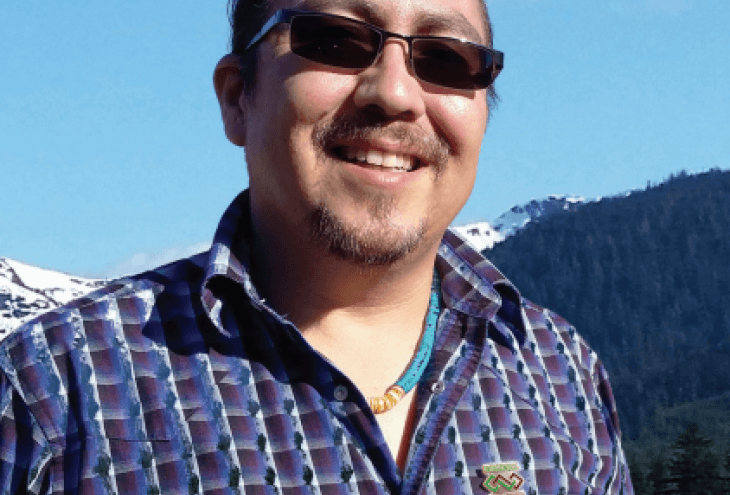Entrepreneur and software trailblazer Paul Kabotie is taking a moment to reflect. It’s been a while since he’s retraced his road to here and now — he’s become a successful professional, happy family man, and proud member of the AISES Board of Directors. “When I was starting out on my own, I couldn’t possibly have known how things would work out,” says Kabotie. “It really was about always taking the next step forward, no matter what.”
A member of the Hopi and Santa Clara Pueblo tribes, Kabotie took his first steps on the Santa Clara Pueblo Reservation in New Mexico. Growing up, his study skills “were seriously lacking,” but he was a quick learner and good test taker. Things weren’t going well at home, however, where he, his siblings, and his mother lived with his troubled stepfather. When Kabotie was 14, his stepfather kicked him out of the house, so he went to live with an aunt. When he turned 16, Kabotie took the bold step of becoming legally emancipated. “I’m not sure how I managed my way through that process, but I was motivated,” he recalls. His determination also showed up in his academic achievements. Kabotie had the highest ACT test score in his class and qualified for early-admission college courses. The same year he was emancipated, he enrolled at Highlands University about 100 miles away. While technically a high school senior, he earned dual high school and college credits at Highlands and qualified for enough financial aid to make it possible. That year he made the dean’s list and felt he was ready for the “big time” of the University of New Mexico in Albuquerque.
Kabotie enrolled in UNM’s College of Engineering. “The career map on the back of the ACT results put me squarely in the engineering section. That made sense — I had always been interested in how things work — phones, recorders, everything,” he says. Kabotie researched grants and scholarships, applying for and receiving more than a dozen, from small awards to larger tuition grants.
When the 17-year-old arrived on the university campus, he found there was a lot to navigate. “The city of Albuquerque seemed to be a concrete jungle,” he recalls. “I showed up the first day with no classes on my schedule, and it took me two weeks just to get registered.” Then, with courses secured, he learned of one destination he became determined to find: the 1983 AISES National Conference, gathering right there in Albuquerque.
“Of the 25,000 students at UNM, I hadn’t met one other Native American, but at the convention, eight of us found one other,” he recounts. “That was huge. We decided on the spot to start an AISES College Chapter. We were officially sanctioned by the time the event was over, and even got to announce it at the conference.”
Things were coming together. A required class introduced Kabotie to computer programming and opened his eyes to the accessibility of the technology and its unlimited possibilities. He started taking computer science classes, and eventually switched his major. Representatives from the Jet Propulsion Laboratory, on a visit to campus, saw a computer running software Kabotie had written and offered him an internship.
But once back at school after his internship, Kabotie had to face some hard reality. It became clear that his study habits — those that served him well enough at a local college — weren’t holding up to the demands of the university. His grades suffered, and eventually he dropped out. He stayed in Albuquerque working various jobs, and kept in touch with friends from AISES. “They would always say to me, ‘come back when you’re ready.’”
Eventually, he did. By 1989, Kabotie was back on track academically and had landed a summer internship at a Denver-based company developing breakthrough telephone technology. That led to a second internship the next summer, when he found himself working alongside a programmer from Stanford. “He and a group of other Native American students living and working in Denver got together regularly, and he invited me along,” Kabotie explains. “It turns out that Lesley was part of the group. That became my crowd. And by the end of the summer, Lesley and I were dating.” Today Lesley is his wife, as well as a partner in and cofounder of their Lakewood, Colo.–based business, Indigenous Collaboration.
By 1991 Kabotie had graduated from UNM with a bachelor’s degree in computer science and a minor in communication. “I used to joke in college that I was on the 10-year plan,” he says with a smile. “Sure enough, at the time I graduated it had been almost that — nine and a half years.” Four grown sons, a strong marriage, and a power-career path later, Kabotie now works with his wife running their business. The work is a blend of each of their areas of expertise: his in systems and processes, and hers in facilitation and nonprofit management (in which she holds a master’s degree).
“I look back on my life journey and can appreciate how all the experiences I’ve had have shaped who I am now,” says Kabotie, who also serves on the Hopi Foundation Board of Trustees and will enter the Colorado State University Executive MBA program in August. “AISES made such a difference for me in so many ways; it’s important for me to share my story.”











